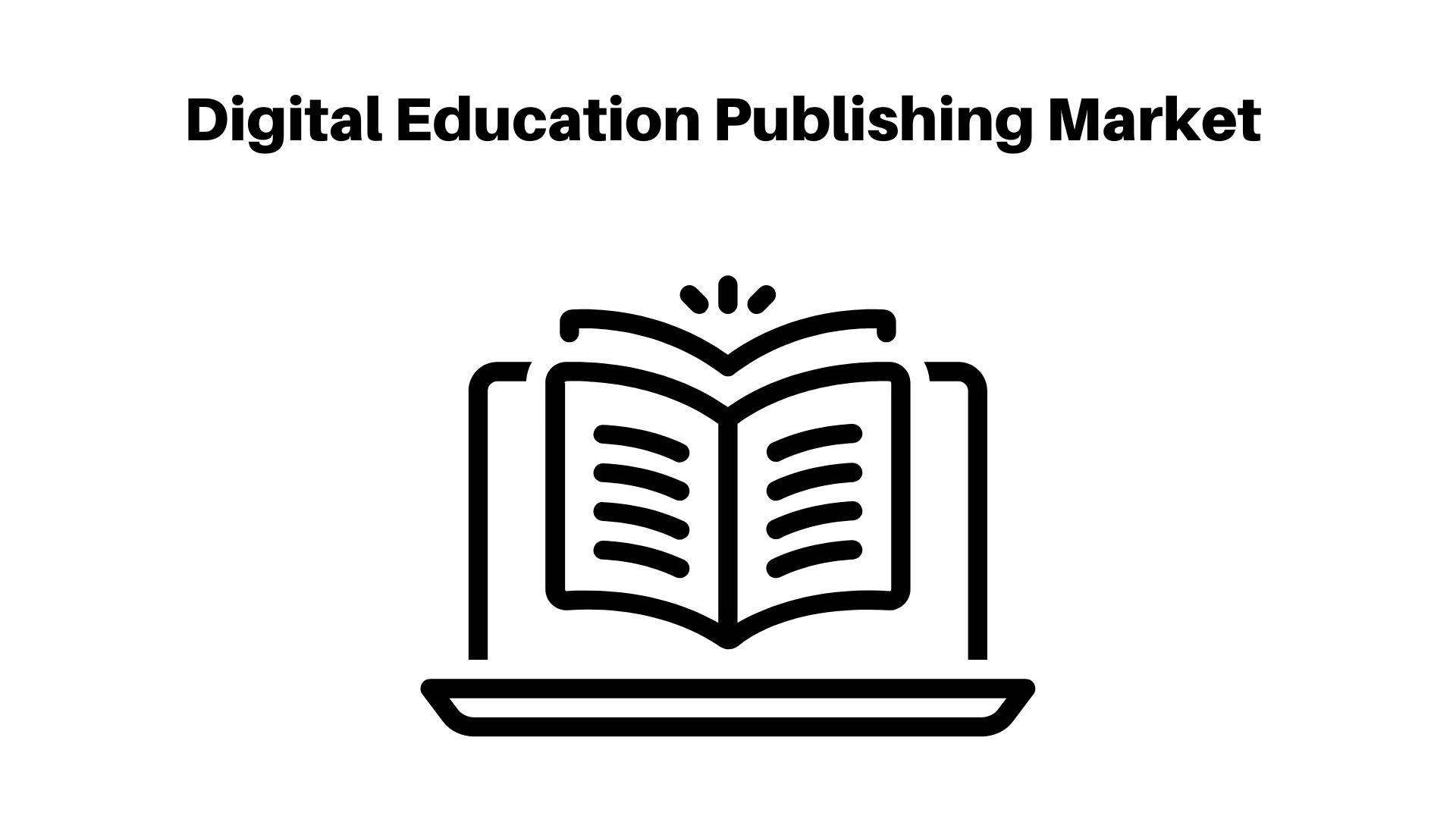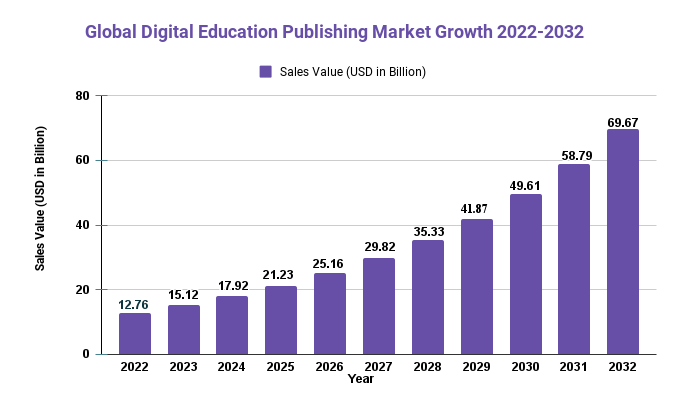Digital Education Publishing Market Size (USD 69.67 billion by 2032) with 18.5% CAGR

Page Contents
Market Overview
The digital education publishing market is expanding rapidly due to the increasing demand for digital educational resources and e-learning solutions. This includes developing and distributing learning materials such as e-books, online courses, interactive simulations, and educational software. The sector has seen considerable expansion over recent years and is forecasted to continue expanding in the coming years due to factors such as increasing adoption of e-learning and online education, personalized learning solutions demand, and mobile learning trends.
According to Market.us' report, the global digital education publishing market size is projected to grow from USD 12.76 billion in 2022 to USD 69.67 billion by 2032 at an annual compound growth rate (CAGR) of 18.5% during the forecast period. North America is anticipated to hold the largest market share during this time frame followed by Europe and Asia Pacific.
One major trend in digital education publishing is the increasing use of Artificial Intelligence (AI) and Machine Learning (ML) technologies to develop adaptive learning solutions. These systems personalize student experiences based on individual needs, preferences, and learning styles – improving student engagement and outcomes while helping educators identify areas where extra support may be necessary.
Another trend in educational technology is the growing acceptance of mobile learning, which gives students access to educational content on their phones anytime, anywhere. This has sparked the development of tailored-for-mobile solutions with features like offline access and responsive design.
The COVID-19 pandemic has catalyzed the growth of the digital education publishing market, as online learning has become an essential necessity. With schools and universities closing, educators and students must rely on digital resources to continue their studies.
Get a Preview PDF of the Report here >> https://market.us/report/digital-education-publishing-market/request-sample/

Key Takeaways
- The digital education publishing market is projected to experience significant growth over the coming years due to the increasing adoption of digital learning resources and e-learning solutions.
- The COVID-19 pandemic has spurred the growth of this market, necessitating it to move towards online learning as a necessity.
- The Asia-Pacific region is anticipated to experience the highest growth rate in this market due to the increasing adoption of digital learning resources and e-learning solutions in countries such as China and India.
- The major players in this market include Pearson Education, McGraw-Hill Education, Houghton Mifflin Harcourt, and Cengage Learning.
Regional Snapshot
The digital education publishing market is divided into North America, Europe, Asia-Pacific, and the Rest of the World. The Asia-Pacific region is expected to witness the highest growth rate in this space due to the increasing adoption of digital learning resources and e-learning solutions in countries such as China and India.
North America is the leading market for digital education publishing, followed by Europe. The presence of major players in these regions and the increasing adoption of e-learning solutions by educational institutions are fueling market expansion within these territories.
Grow your profit margin with Market.us Get this Report
Drivers
- Growing demand for digital educational resources and e-learning solutions
- Increased adoption of mobile learning and online education
- Technological advances in digital publishing
- Rise in internet penetration and smartphone usage
- Need for cost-effective yet flexible learning solutions.
Restraints
- Absence of digital infrastructure in underdeveloped regions
- A high initial investment is required to develop digital educational resources
- Difficulty adopting new technologies for some educators and students.
- Concerns Over Quality and Accuracy of Digital Learning Resources
Overall, the digital education publishing market is forecast to expand rapidly over the coming years due to the increasing adoption of digital learning resources and e-learning solutions in countries such as China and India. Asia-Pacific region is expected to experience the highest growth rate within this space due to the rapid rise of these solutions there.
Opportunities
- Reach: Digital education publishing can reach a broader audience, particularly those living in remote locations who may not have access to traditional educational resources.
- Customization: Digital education publishing provides students with the option to customize educational materials according to their individual or group needs.
- Interactivity: Digital education publishing can offer interactive elements such as quizzes, simulations, and videos to make learning more captivating and efficient.
- Cost-Effective: Digital education publishing can be more economical than traditional print publishing due to the absence of printing and distribution expenses.
- Analytics: Digital education publishing allows for tracking student progress and collecting data on how students are engaging with instructional materials, which can help enhance teaching and learning processes.
Challenges
- Access: Not all students have reliable internet and technology, which can limit the reach of digital education publishing.
- Quality Control: Low-grade educational materials may be distributed online, making it harder for students to learn effectively.
- Digital Divide: The digital divide that exists between developed and developing countries can result in disparities in access to digital education publishing resources.
- Copyright Violations: Digital education publishing can put learners at greater risk of copyright infringement since it is easier to copy and distribute digital materials.
- Resistance to Change: Some educators may resist the move towards digital education publishing due to a preference for traditional teaching methods.
Recent Advances in Digital Education Publishing
Open Educational Resources (OERs): OERs are educational materials that are freely licensed for use, reuse, and distribution – making them a cost-effective way to provide high-quality educational materials to students.
Gamification: Digital education publishing is increasingly incorporating gamification techniques to make learning more engaging and effective.
Adaptive Learning: Digital education publishing can utilize adaptive learning algorithms to customize instructional materials based on each student's individual needs, making learning more efficient and effective.
Augmented and Virtual Reality: Digital education publishing is increasingly incorporating augmented and virtual reality technologies to provide immersive learning experiences for students.
Mobile Learning: Digital education publishing is increasingly optimizing its materials for mobile devices, enabling students to access educational materials anytime, anywhere.
Key Market Segments
Type
- Online book
- Online Magazine
- Online Catalog
Application
- K-12
- Higher education
- Corporate/skill-based
Key Market Players included in the report
- Georg von Holtzbrinck GmbH
- Hachette Livre
- McGraw-Hill Education
- Pearson plc
- Cambridge University Press
- Cengage Learning
- John Wiley & Sons
- Oxford University Press
- Thomson Reuters
Report Scope
| Report Attribute | Details |
| The market size value in 2022 | USD 12.76 Bn |
| Revenue forecast by 2032 | USD 69.67 Bn |
| Growth Rate | CAGR Of 18.5% |
| Regions Covered | North America, Europe, Asia Pacific, Latin America, and Middle East & Africa, and Rest of the World |
| Historical Years | 2017-2022 |
| Base Year | 2022 |
| Estimated Year | 2023 |
| Short-Term Projection Year | 2028 |
| Long-Term Projected Year | 2032 |
Before obtaining this report, contact the seller at >> https://market.us/report/digital-education-publishing-market/#inquiry
Frequently Asked Questions
Q: What is digital education publishing?
Digital education publishing refers to the creation, distribution, and management of educational materials in electronic forms such as e-books, videos, simulations, and other interactive media.
Q: What are the advantages of digital education publishing?
A: Digital educational publishing offers several advantages, such as wider reach, customization, interactivity, cost efficiency, and analytics.
Q: What are the challenges of digital education publishing?
A: Some issues facing this space include access, quality control, the digital divide, copyright infringement, and resistance to change.
Q: What are Open Educational Resources (OERs)?
OERs are educational materials that are freely licensed for use, reuse, and distribution – providing cost-effective access to high-quality learning resources for students.
Q: What is adaptive learning?
A: Adaptive learning is a digital education publishing technique that uses algorithms to customize educational materials according to each student's individual needs, making learning more efficient.
Q: What is Gamification?
Gamification is the use of game-like elements like points, badges, and leaderboards to make learning more engaging and effective.
Q: What is Mobile Learning?
Mobile learning refers to the optimization of educational materials for mobile devices, enabling students to access those resources anytime, anywhere.
The team behind market.us, marketresearch.biz, market.biz and more. Our purpose is to keep our customers ahead of the game with regard to the markets. They may fluctuate up or down, but we will help you to stay ahead of the curve in these market fluctuations. Our consistent growth and ability to deliver in-depth analyses and market insight has engaged genuine market players. They have faith in us to offer the data and information they require to make balanced and decisive marketing decisions.



